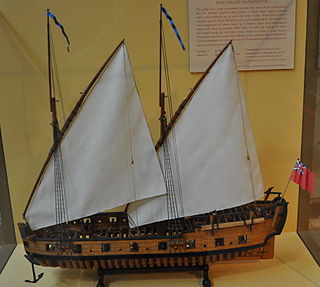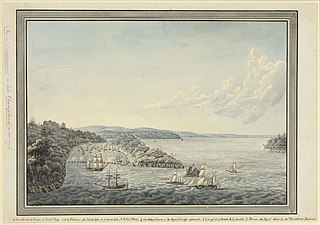
The Battle of Valcour Island, also known as the Battle of Valcour Bay, was a naval engagement that took place on October 11, 1776, on Lake Champlain. The main action took place in Valcour Bay, a narrow strait between the New York mainland and Valcour Island. The battle is generally regarded as one of the first naval battles of the American Revolutionary War, and one of the first fought by the United States Navy. Most of the ships in the American fleet under the command of Benedict Arnold were captured or destroyed by a British force under the overall direction of General Guy Carleton. However, the American defense of Lake Champlain stalled British plans to reach the upper Hudson River valley.
USS Enterprise was a Continental Army sloop-of-war that served in Lake Champlain during the American Revolutionary War. She was the first of a long and prestigious line of ships of the United States or by the combatant forces of the U.S. Revolutionary War to bear the name Enterprise.

The Battle of Plattsburgh, also known as the Battle of Lake Champlain, ended the final British invasion of the northern states of the United States during the War of 1812. Two British forces, an army under Lieutenant General Sir George Prévost and a naval squadron under Captain George Downie converged on the lakeside town of Plattsburgh, New York. Plattsburgh was defended by New York and Vermont militia and detachments of regular troops of the United States Army, all under the command of Brigadier General Alexander Macomb, and ships commanded by Master Commandant Thomas Macdonough.
USS Julia was a schooner in the United States Navy during the War of 1812. Initially the privately-owned schooner Julia, she was captured at the onset of the war by armed boats looking for violators of President James Madison's embargo of trade with the British. Purchased by the United States Navy, the vessel was armed with two guns and made part of the squadron on Lake Ontario. Julia took part in the Battle of York and the Battle of Fort George. In August 1813, the schooner was captured by the Royal Navy after failing to execute a turn and was put in service as HMS Confiance. The vessel continued as a warship in British service for a couple of weeks before being converted to a troop transport. In October, Confiance was recaptured by the Americans and renamed Julia. No longer considered capable as a warship, the vessel was retired from service.

The first USS Revenge was a Schooner in the Continental Navy. Revenge was built in the summer of 1776 by Colonel Jeduthan Baldwin at Fort Ticonderoga, New York.

HMS Confiance was a 36-gun fifth-rate frigate that served in the Royal Navy on Lake Champlain during the War of 1812. Confiance served as Captain George Downie's flagship at the Battle of Plattsburgh, on 11 September 1814. Surrendered to the American Squadron following a nearly 2½ hour battle, she was eventually taken to Whitehall, New York where she was taken into the U.S. Navy and placed in ordinary. The vessel was formally abandoned by the Navy in 1820 and after being partially salvaged, was allowed to sink at her moorings. As a danger to navigation, the sunken hulk was destroyed with dynamite charges during dredging operations on the channel in 1873.
The USS Liberty was a schooner built at Skenesboro, New York, on Lake Champlain, for wealthy landowner and former British Army Captain Philip Skene. It was captured on 11 May 1775 during a raid on Skenesboro led by Capt. Samuel Herrick, an early action in the American Revolution.

The Engagements on Lake Ontario encompass the prolonged naval contest for control of the lake during the War of 1812. Few actions were fought, none of which had decisive results. The contest essentially became a naval building race, sometimes referred to sarcastically as the "Battle of the Carpenters."
David Hawley (1741–1807) was a captain in the Continental Navy and a privateer during the American Revolutionary War. He commanded Royal Savage in the 1776 Battle of Valcour Island, which is generally regarded as one of the first naval battles of the American Revolutionary War, and one of the first fought by the United States Navy.

USS Philadelphia is a gunboat of the Continental Navy. She was constructed from July–August 1776 for service during the American Revolutionary War. Manned by Continental Army soldiers, she was part of a fleet under the command of General Benedict Arnold that fought against the British Royal Navy in the Battle of Valcour Island on Lake Champlain. Philadelphia was sunk during the battle on 11 October 1776.

Valcour Bay is actually a strait or sound, located between Valcour Island and the west side of Lake Champlain, four miles south of Plattsburgh, New York. It was the site of the Battle of Valcour Island during the American Revolutionary War. It was declared a National Historic Landmark in 1961 because of this association. Valcour Bay is located in the Towns of Peru and Plattsburgh, both in Clinton County, New York.

The first USS Boston was a gundalow built at Skenesborough, New York, in 1776, with a crew of 45 for General Benedict Arnold's short-lived Lake Champlain Fleet. She took part in the Battle of Valcour Island that delayed the British invasion. She was probably commissioned sometime early in August 1776, with a Captain Sumner in command.

USS Washington was a lateen-rigged, two-masted galley in the service of the Continental Congress during the American Revolutionary War. Washington was capable of propulsion by sail or by the rowing of oarsmen. During a battle with British warships, Washington "struck her colors" and was captured by the British.
USS Lee was a galley built for the Continental Navy during the American Revolution. She participated in the Battle of Valcour Island during which she was grounded and lost. However, her participation in the battle helped delay the British advance on New York City by a year.
USS Spitfire was an American gundalow that operated as a gunboat in 1776 on Lake Champlain. She was part of Benedict Arnold's small, hastily built fleet of ships whose purpose was to counter any British invasion forces passing through the lake from Canada. Her service life was brief; after only a few months patrolling the lake she was lost in the aftermath of the Battle of Valcour Island. The gunboat's wreck was located and documented in the 1990s by the Lake Champlain Maritime Museum.

James Richard Dacres was an officer of the Royal Navy who saw service during the Seven Years' War, the American War of Independence and the French Revolutionary and Napoleonic Wars. He eventually rose to the rank of Vice-Admiral.
New York (1776) was a gunboat built in 1776 at Skenesboro, New York. It was originally called Success prior to launch for service in General Benedict Arnold's fleet on Lake Champlain. New York may be named after the City of New York, because other ships in the fleet were named after cities, however, it could be named after the State of New York, because at least one or two other ships, Connecticut and Jersey, sometimes referred to as New Jersey, were named after states.
The first USS Trumbull was a row galley built in 1776 at Skenesboro, New York, for service in General Benedict Arnold's fleet on Lake Champlain. She was launched on 10 September 1776 and began active service soon thereafter, Capt. Seth Warner in command.
HMS Gaspée was purchased in North America in 1772, commissioned in 1773, and captured in 1775. The Royal Navy recaptured her in 1776. She was recommissioned and served again until prepared for disposal at the end of 1777. At some point she was at the "Battle of Fundy", but when this occurred and what her role was is currently obscure.

HMS Maria was a schooner that the Americans captured in 1775 and that the British recaptured on 7 May 1776 at Quebec City and took into the Royal Navy.











